A Shipborne Doppler Lidar Investigation of the Winter Marine Atmospheric Boundary Layer over Southeastern China’s Coastal Waters
Abstract
1. Introduction
2. Data and Methods
2.1. Shipborne Cruise Experiment
2.2. Coherent Doppler Wind Lidar
2.3. ERA5 Reanalysis Dataset
2.4. Wind Shear Calculation
2.5. Empirical Orthogonal Function Analysis
3. Results
3.1. Characteristics of MABL Height
3.2. Wind Field Characteristics
3.3. Pollution Episode
4. Discussion
5. Conclusions
Author Contributions
Funding
Data Availability Statement
Conflicts of Interest
References
- Rogers, D.P.; Johnson, D.W.; Friehe, C.A. The stable internal boundary layer over a coastal sea. Part I: Airborne measurements of the mean and turbulence structure. J. Atmos. Sci. 1995, 52, 667–683. [Google Scholar] [CrossRef]
- Wulfmeyer, V.; Janjić, T. Twenty-four-hour observations of the marine boundary layer using shipborne NOAA high-resolution Doppler lidar. J. Appl. Meteorol. 2005, 44, 1723–1744. [Google Scholar] [CrossRef]
- Zhai, X.; Wu, S.; Liu, B.; Song, X.; Yin, J. Shipborne wind measurement and motion-induced error correction of a coherent Doppler lidar over the Yellow Sea in 2014. Atmos. Meas. Tech. 2018, 11, 1313–1331. [Google Scholar] [CrossRef]
- Rubio, H.; Kühn, M.; Gottschall, J. Evaluation of low-level jets in the southern Baltic Sea: A comparison between ship-based lidar observational data and numerical models. Wind. Energy Sci. 2022, 7, 2433–2455. [Google Scholar] [CrossRef]
- Shu, Z.R.; Li, Q.S.; He, Y.C.; Chan, P.W. Observations of offshore wind characteristics by Doppler-LiDAR for wind energy applications. Appl. Energy 2016, 169, 150–163. [Google Scholar] [CrossRef]
- Wang, T.; Jiang, F.; Deng, J.; Shen, Y.; Fu, Q.; Wang, Q.; Fu, Y.; Xu, J.; Zhang, D. Urban air quality and regional haze weather forecast for Yangtze River Delta region. Atmos. Environ. 2012, 58, 70–83. [Google Scholar] [CrossRef]
- Yang, Y.; Zheng, X.; Gao, Z.; Wang, H.; Wang, T.; Li, Y.; Lau, G.N.; Yim, S.H. Long-term trends of persistent synoptic circulation events in planetary boundary layer and their relationships with haze pollution in winter half year over eastern China. J. Geophys. Res.-Atmos. 2018, 123, 10–991. [Google Scholar] [CrossRef]
- Zheng, Z.; Li, Y.; Wang, H.; Ding, H.; Li, Y.; Gao, Z.; Yang, Y. Re-evaluating the variation in trend of haze days in the urban areas of Beijing during a recent 36-year period. Atmos. Sci. Lett. 2018, 20, e878. [Google Scholar] [CrossRef]
- Zentek, R.; Kohnemann, S.H.; Heinemann, G. Analysis of the performance of a ship-borne scanning wind lidar in the Arctic and Antarctic. Atmos. Meas. Tech. 2018, 11, 5781–5795. [Google Scholar] [CrossRef]
- Tucker, S.C.; Senff, C.J.; Weickmann, A.M.; Brewer, W.A.; Banta, R.M.; Sandberg, S.P.; Hardesty, R.M. Doppler lidar estimation of mixing height using turbulence, shear, and aerosol profiles. J. Atmos. Ocean. Tech. 2009, 26, 673–688. [Google Scholar] [CrossRef]
- Achtert, P.; Brooks, I.M.; Brooks, B.J.; Moat, B.I.; Prytherch, J.; Persson, P.O.G.; Tjernström, M. Measurement of wind profiles by motion-stabilised ship-borne Doppler lidar. Atmos. Meas. Tech. 2015, 8, 4993–5007. [Google Scholar] [CrossRef]
- Pichugina, Y.L.; Banta, R.M.; Brewer, W.A.; Sandberg, S.P.; Hardesty, R.M. Doppler lidar-based wind-profile measurement system for offshore wind-energy and other marine boundary layer applications. J. Appl. Meteorol. Clim. 2012, 51, 327–349. [Google Scholar] [CrossRef]
- Kumer, V.M.; Reuder, J.; Dorninger, M.; Zauner, R.; Grubišić, V. Turbulent kinetic energy estimates from profiling wind LiDAR measurements and their potential for wind energy applications. Renew. Energy 2016, 99, 898–910. [Google Scholar] [CrossRef]
- Wang, X.; Dai, G.; Wu, S.; Zhu, P.; Li, Z.; Song, X.; Zhang, S.; Xu, J.; Yin, J.; Qin, S.; et al. Classification of turbulent mixing driven sources in marine atmospheric boundary layer with use of shipborne coherent doppler lidar observations. J. Geophys. Res.-Atmos. 2023, 128, e2023JD038918. [Google Scholar] [CrossRef]
- Flamant, C.; Pelon, J.; Flamant, P.H.; Durand, P. Lidar determination of the entrainment zone thickness at the top of the unstable marine atmospheric boundary layer. Bound.-Lay. Meteorol. 1997, 83, 247–284. [Google Scholar] [CrossRef]
- Hersbach, H.; Bell, B.; Berrisford, P.; Biavati, G.; Horányi, A.; Muñoz Sabater, J.; Nicolas, J.; Peubey, C.; Radu, R.; Rozum, I.; et al. ERA5 Hourly Data on Single Levels from 1940 to Present [Dataset]. Copernicus Climate Change Service (C3S) Climate Data Store (CDS). 2023. Available online: https://cds.climate.copernicus.eu/datasets/reanalysis-era5-single-levels?tab=overview (accessed on 22 April 2025).
- Pearson, K. On lines and planes of closest fit to systems of point in space. Philos. Mag. 1901, 2, 559–572. [Google Scholar] [CrossRef]
- Lorenz, E.N. Empirical Orthogonal Functions and Statistical Weather Prediction; Sci. Rep. 1; Massachusetts Institute of Technology, Department of Meteorology: Cambridge, MA, USA, 1956. [Google Scholar]
- Stull, R.B. An Introduction to Boundary Layer Meteorology; Springer: Berlin/Heidelberg, Germany, 1988. [Google Scholar]
- Banta, R.M.; Senff, C.J.; White, A.B.; Trainer, M.; McNider, R.T.; Valente, R.J.; Fehsenfeld, F.C. Daytime buildup and nighttime transport of urban ozone in the boundary layer during a stagnation episode. J. Geophys. Res.-Atmos. 1998, 103, 22519–22544. [Google Scholar] [CrossRef]
- Banta, R.M.; White, A.B. Mixing-height differences between land use types: Dependence on wind speed. J. Geophys. Res.-Atmos. 2003, 108, 4321. [Google Scholar] [CrossRef]
- Du, Y.; Chen, Y.; Zhang, Q. Numerical simulations of the boundary layer jet off the southeastern coast of China. Mon. Weather Rev. 2015, 143, 1212–1231. [Google Scholar] [CrossRef]
- Cui, L.; Song, X.; Yang, Y.; Liu, J.; Li, Z.; Yun, L.; Zhang, M. Doppler lidar retrieval of particulate matter concentration based on statistical regression method. Acta Photon. Sin. 2021, 50, 1201005. [Google Scholar] [CrossRef]
- Chouza, F.; Reitebuch, O.; Groß, S.; Rahm, S.; Freudenthaler, V.; Toledano, C.; Weinzierl, B. Retrieval of aerosol backscatter and extinction from airborne coherent Doppler wind lidar measurements. Atmos. Meas. Tech. 2015, 8, 2909–2926. [Google Scholar] [CrossRef]
- Dai, G.; Wang, X.; Sun, K.; Wu, S.; Song, X.; Li, R.; Yin, J.; Wang, X. Calibration and retrieval of aerosol optical properties measured with Coherent Doppler Lidar. J. Atmos. Ocean. Technol. 2021, 38, 1035–1045. [Google Scholar] [CrossRef]

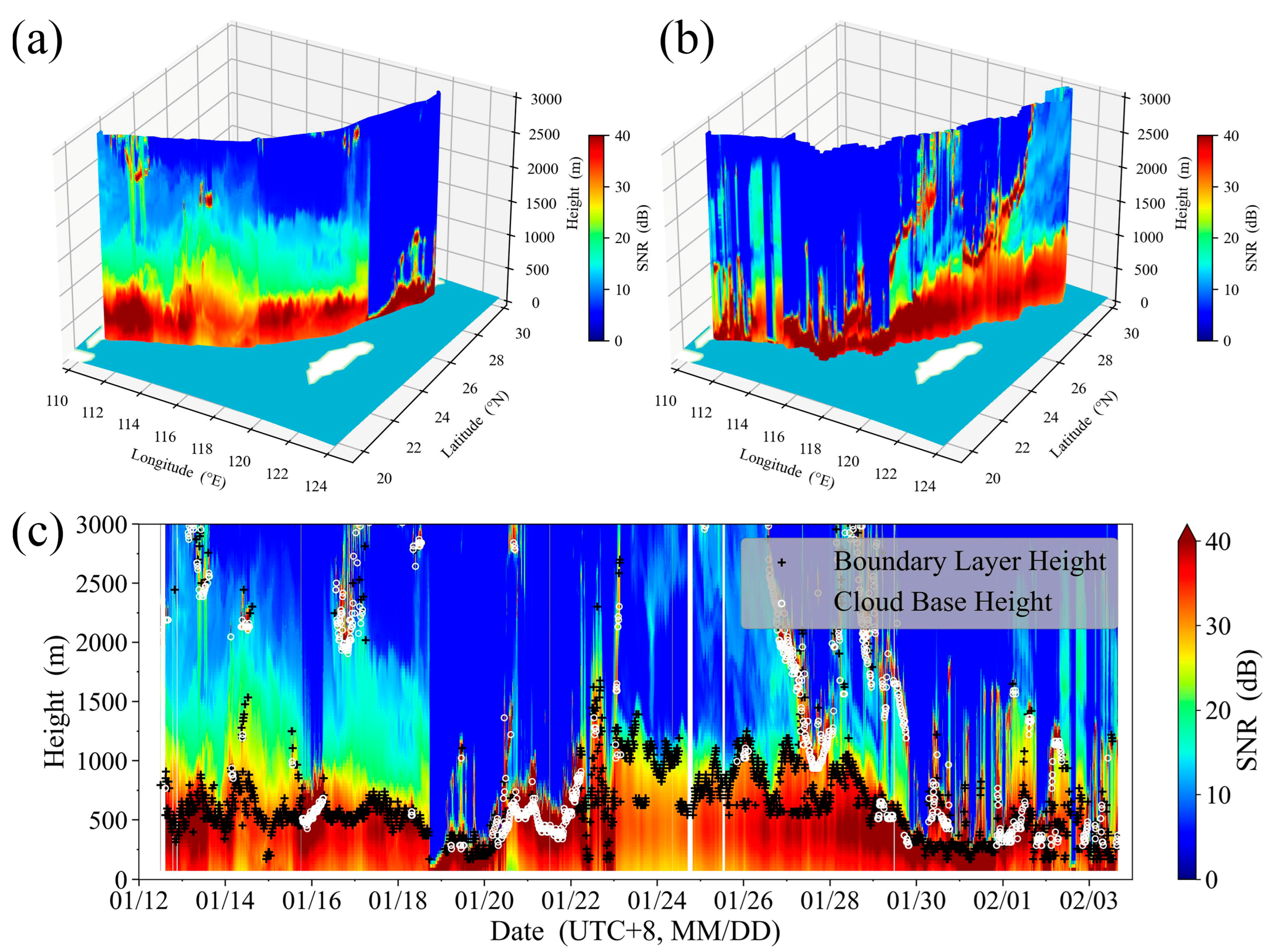


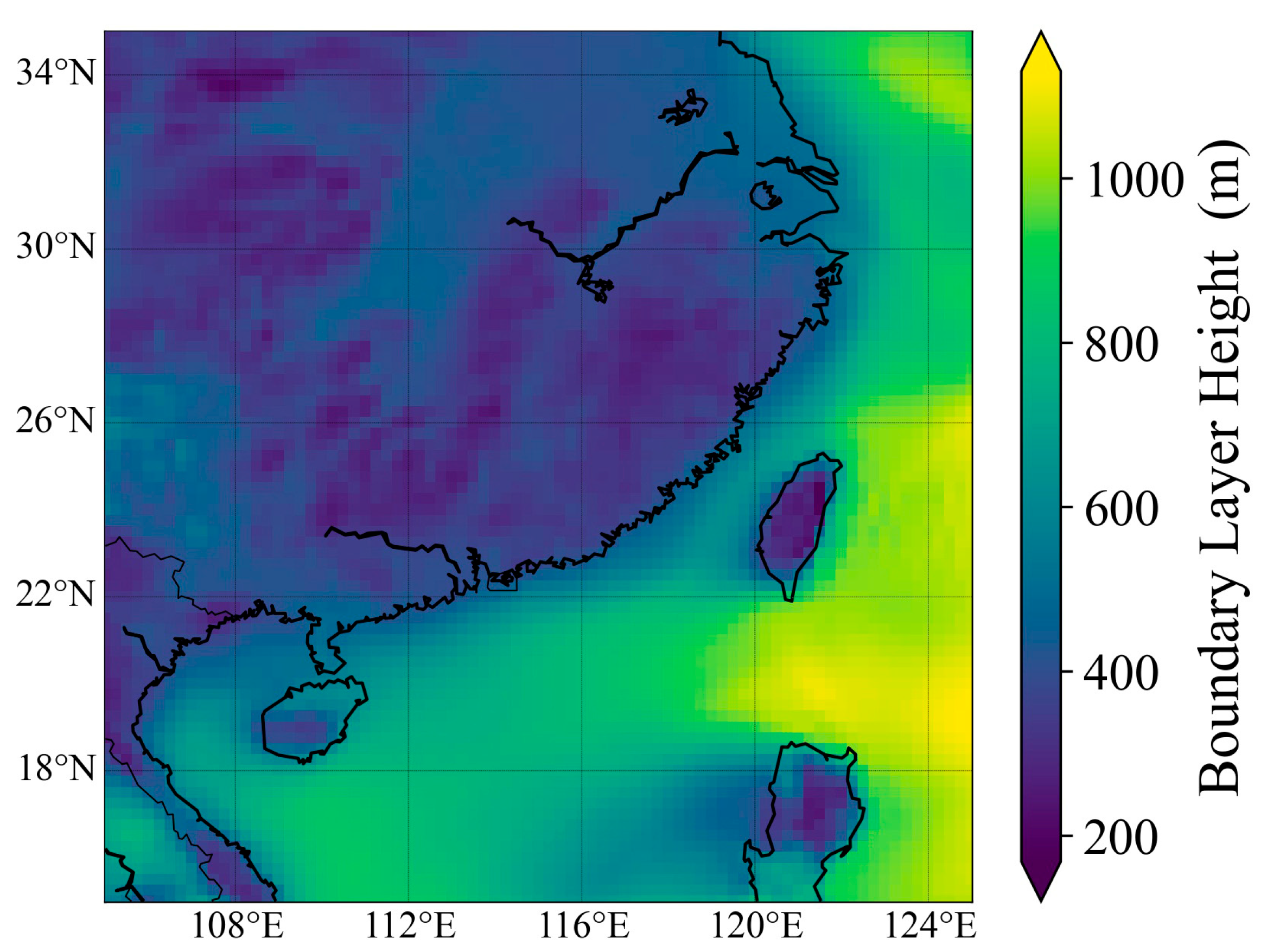

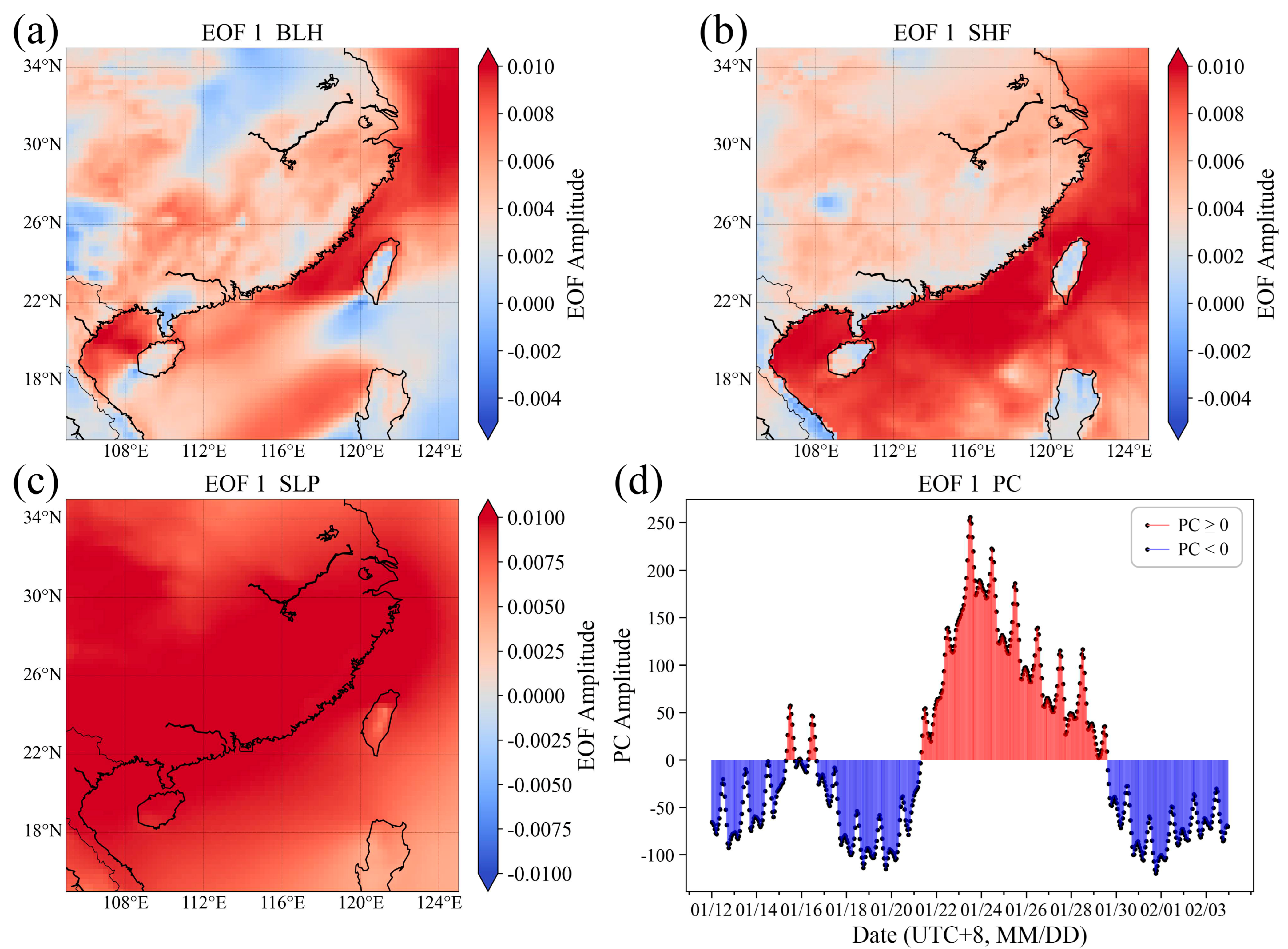
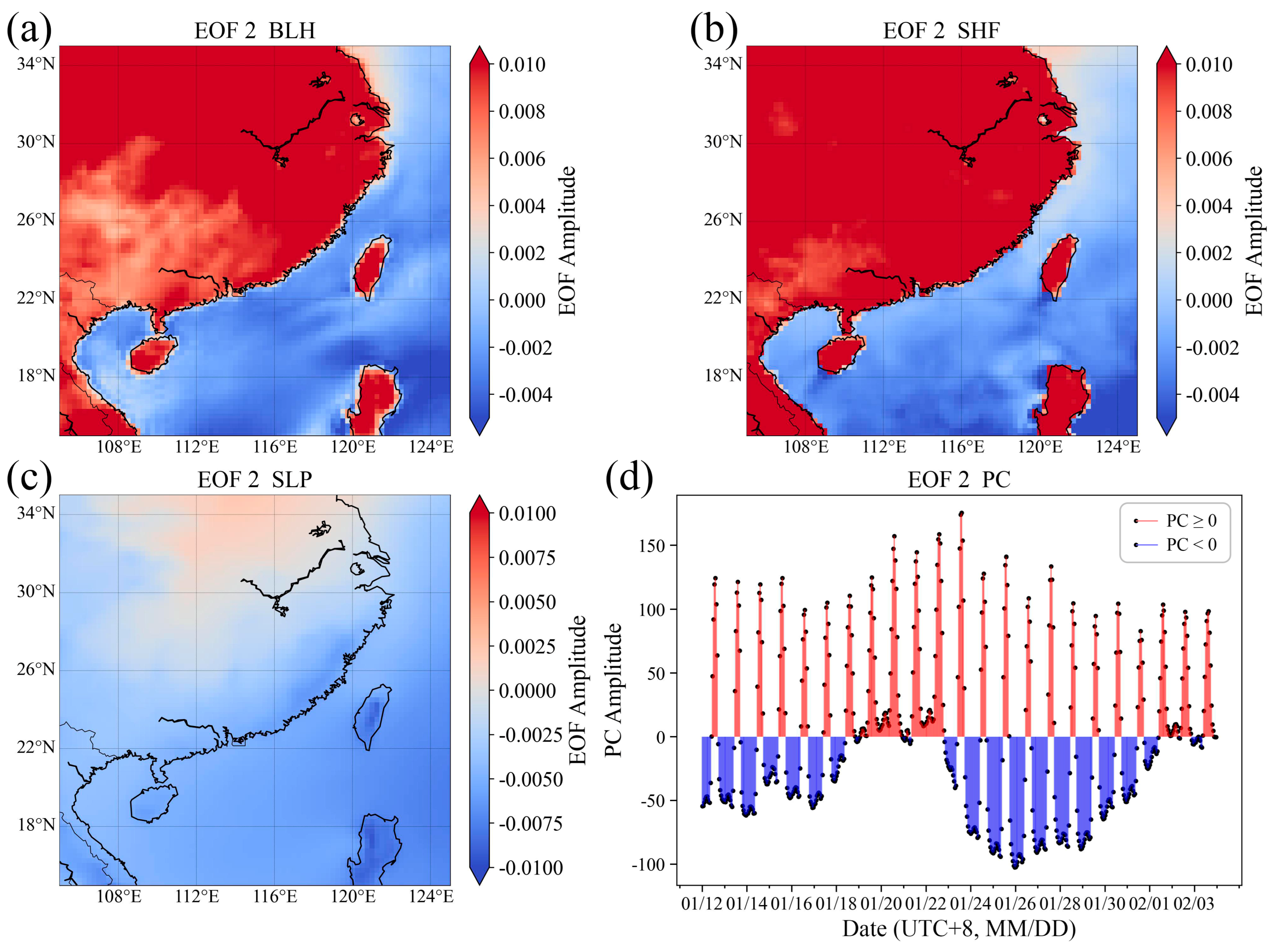
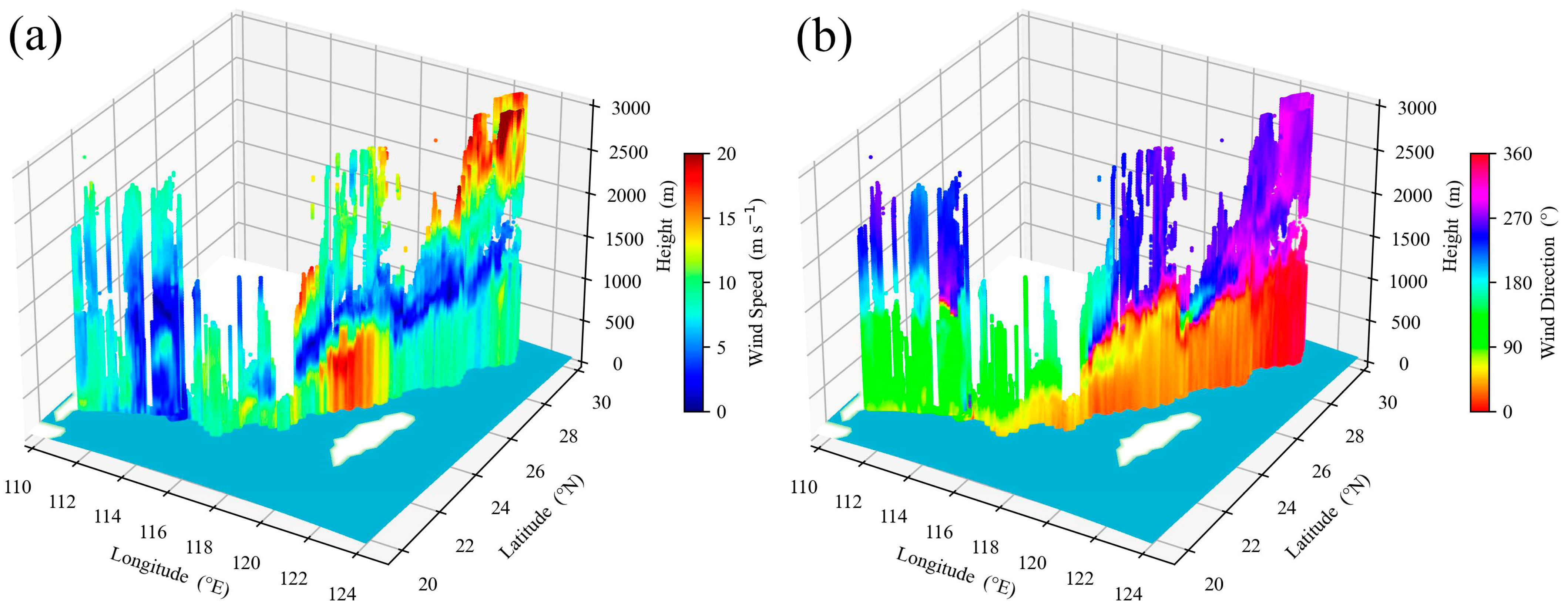

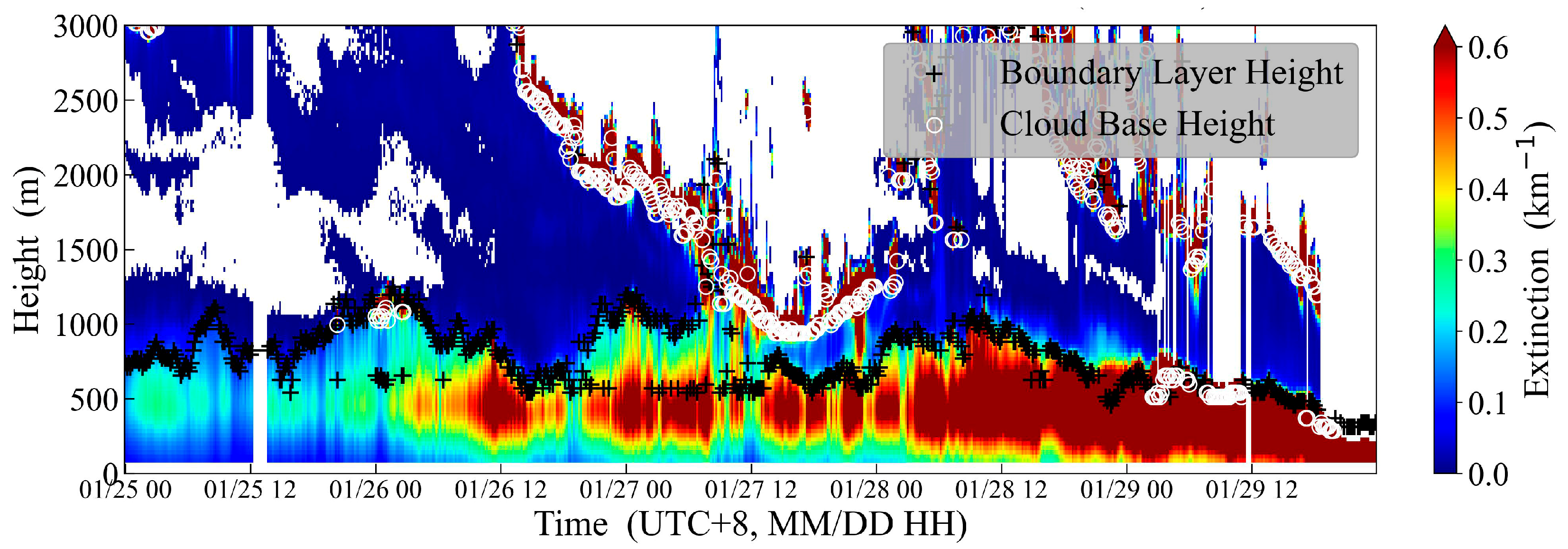
| Parameters | Value |
|---|---|
| Laser wavelength | 1550 nm |
| Pulse repetition frequency | 10 kHz |
| Scan mode | Doppler beam swing mode (4 beams with an elevation angle of about 70° pointing to the east, south, west, and north of the device, as well as a vertical upward beam) |
| Single-beam accumulation time | 1 s |
| Complete scanning cycle time | 16 s |
| Product | Temporal Resolution | Spatial Resolution |
|---|---|---|
| Wind speed | 10 min average (averaged from originally measured profiles) | Detection altitude range: 85–8585 m; Vertical resolution: 28 m |
| Wind direction | ||
| SNR | ||
| Aerosol extinction coefficient | ||
| BLH | ||
| Cloud base height |
| Product | Temporal Resolution | Spatial Resolution |
|---|---|---|
| BLH | 1 h | Selected domain range: 105°E–125°E, 15°N–35°N; Grid resolution: 0.25° × 0.25° |
| Skin temperature (SKT) | ||
| Surface sensible heat flux (SHF) | ||
| Sea level pressure (SLP) |
Disclaimer/Publisher’s Note: The statements, opinions and data contained in all publications are solely those of the individual author(s) and contributor(s) and not of MDPI and/or the editor(s). MDPI and/or the editor(s) disclaim responsibility for any injury to people or property resulting from any ideas, methods, instructions or products referred to in the content. |
© 2025 by the authors. Licensee MDPI, Basel, Switzerland. This article is an open access article distributed under the terms and conditions of the Creative Commons Attribution (CC BY) license (https://creativecommons.org/licenses/by/4.0/).
Share and Cite
Song, X.; Lian, W.; Wang, F.; Jiang, P.; Wang, J. A Shipborne Doppler Lidar Investigation of the Winter Marine Atmospheric Boundary Layer over Southeastern China’s Coastal Waters. Remote Sens. 2025, 17, 2161. https://doi.org/10.3390/rs17132161
Song X, Lian W, Wang F, Jiang P, Wang J. A Shipborne Doppler Lidar Investigation of the Winter Marine Atmospheric Boundary Layer over Southeastern China’s Coastal Waters. Remote Sensing. 2025; 17(13):2161. https://doi.org/10.3390/rs17132161
Chicago/Turabian StyleSong, Xiaoquan, Wenchao Lian, Fuyou Wang, Ping Jiang, and Jie Wang. 2025. "A Shipborne Doppler Lidar Investigation of the Winter Marine Atmospheric Boundary Layer over Southeastern China’s Coastal Waters" Remote Sensing 17, no. 13: 2161. https://doi.org/10.3390/rs17132161
APA StyleSong, X., Lian, W., Wang, F., Jiang, P., & Wang, J. (2025). A Shipborne Doppler Lidar Investigation of the Winter Marine Atmospheric Boundary Layer over Southeastern China’s Coastal Waters. Remote Sensing, 17(13), 2161. https://doi.org/10.3390/rs17132161







